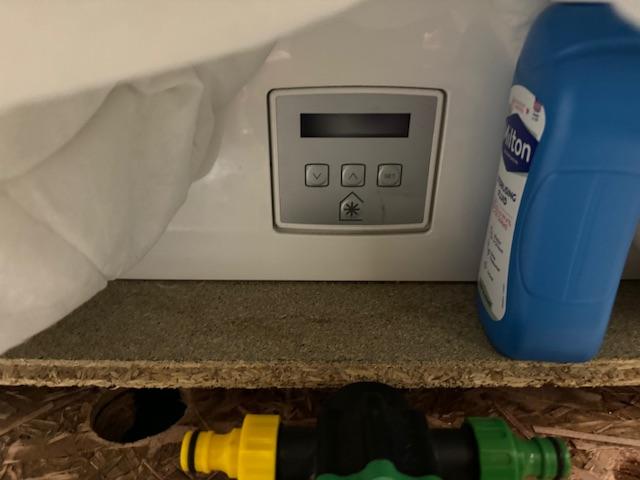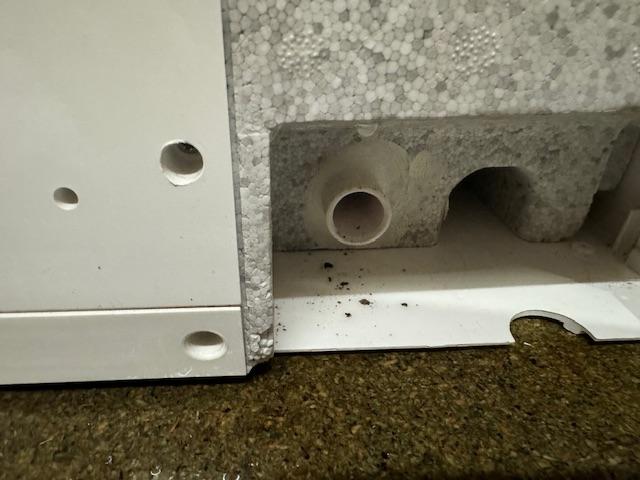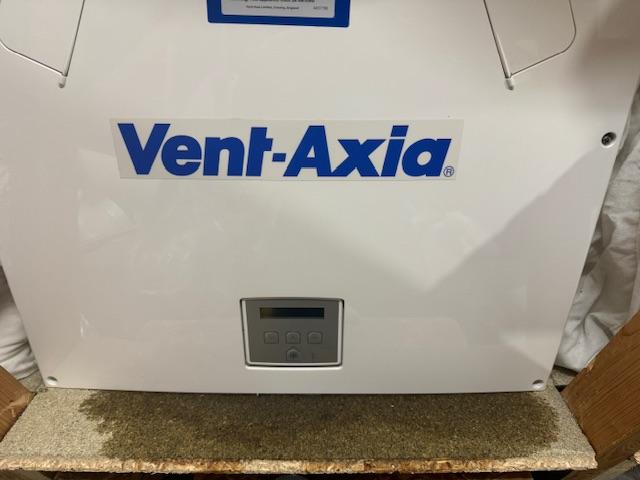
gregcope
Members-
Posts
9 -
Joined
-
Last visited
Personal Information
-
Location
West Sussex
Recent Profile Visitors
The recent visitors block is disabled and is not being shown to other users.
gregcope's Achievements

New Member (2/5)
9
Reputation
-
Something around 10M? This will add drag and hence you might need to run the fans higher to achieve the required room supply/extract rates. Ideally you want the unit near the plenums that are in a “mid point” so that runs are minimised. Reality might be different. For context my unit input / extract are 2M. My house feed is 3M and extract 1M. My unit is in the “middle” of the loft. i would suggest mounting the unit somewhere easy to maintain it. its all a balance of differing priorities.
-
Question about boost
gregcope replied to Coanda's topic in Mechanical Ventilation with Heat Recovery (MVHR)
If the system was not balanced (unintentionally) then if the Boost upped the extract, outside air would be pulled in via leaks and hence by-pass the Heat Exchanger. In the winter (or colder months) this would reduce the efficiency of the system overall. Some MVHRs allow differential settings, I assume to either achieve room flow rates (as pipework will vary) or intentionally - I have read on here that recommendations from Finland and Germany vary for either radon or damp. -
DIY retrofit MVHR design for beginners
gregcope replied to Ommm's topic in Mechanical Ventilation with Heat Recovery (MVHR)
I DIY fitted a MVHR. It works really, really well, however do not under estimate the work in installing. We went from a house that had mould in the bathrooms (no extractor fans) to much better air quality. Running the ducts in the loft was the easiest, for a given value of easy in the loft. Running ducts down to the ground floor took a while as hiding ducting in cupboards and also ensuring the loft end worked was more effort. Fitting the intake/extract vents in the roof was straightforward for a roofer! It took five weekends; One for the intake/extract/condensate drain/unit setup. One for the upstairs rooms (two bathrooms, three bedrooms). Another for an extension bedroom (should have hired a core drill for going through an outside wall that is now internal). Another for downstairs ducts to kitchen and lounge. Another for a downstairs loo that involved dropping part of the ceiling to fit the ceiling duct as I could not access above it. I think I could do it in half the time or less as now more confident. All my parts came from ebay, isells, BPC, Screwfix. I did the design myself with a spreadsheet of room volumes and flow rates. I went slightly below the suggested flow rates for "Normal" rates and over for Boost. I overspeced the ducting to reduce noise (ie twin ducts to all rooms as running these is not much work relatively). I fitted noise silencers. I would go higher for boost, to clear damp air quickly, however above 90% flow rate it is noticeable noisy. We have virtually zero condensation. The odd, tiny bit behind some plantation shutters on some cold nights. Some condensation on a door lock that is a cold bridge in a yet to be vented room (its the hardest to get to) and sometimes on the letterbox flap (needs more insulation!). If you have reasonable loft access and only need to do runs in the loft this will help reduce install effort allot. I assume you could have the intake/exhaust through a gable end which should be quite easy (given value of easy). Think of the condensate drain and where that goes (I suggest a soil vent spigot to keep it warmish). It is great, but allot of work. I would have a strong think of doing it again, but on balance would do it again. I did consider four individual room MVHR as these would be quite allot of work to install (core drilling, running electrical feeds) and these are expensive units. I think this would be cost neutral compared to my MVHR. Maybe slightly less work, but not much. Running costs would be more due to more fans. It would not have improved the air in non-vented rooms compared to MVHR. Your air leaks might be an issue although depending on units you can set them to run intake fans faster than extract to positively pressure the house which will help with internal air quality. This would be slightly less efficient as you are losing air that is not going via the heat exchanger. On either method consider the filters the units have. Mine goes upto M5 (A "Pollen filter" ie 50% of Pm10). Newer models have HEPA level filters. You could DIY a HEPA filter on the intake from BPC/Isells bits. Sorry that turned into an essay... -
DIY Vent Axia Sentinel Kinetic install
gregcope replied to FrazK's topic in Mechanical Ventilation with Heat Recovery (MVHR)
I have a waterless trap and drain into a soil vent pipe via a boss. This works well and has not been an issue and worked without freezing (my previous set up did in -5C). You will need to clean it occasionally as the filters are not 100% efficient, so place it somewhere reasonably easy to get to! Ask me how I know. Even if these do leak, the condensate drain is on the extract side so will vent smells outside. -
Some pictures top is now middle is black mouldy goop bottom is puddle… White thing is an old duvet for insulation! Don’t judge!
- 1 reply
-
- 1
-

-
Hi All, Thought I would share my DIY MVHR challengettes. Unit has run fine for two and a half years. I have regularly changed the filters and inspected the unit. The condensate drain was a pipe that poked out of the roof / wall interface, next to the heating/water overflow. It froze last year in -10C weather so I switched it to drain into an internal soil stack vent. It is now very well insulated. I view this as an install issue, not a unit problem. This December I found a small watch patch under the front and rear covers. I removed the front cover and could not find where the liquid was from. The internal of the unit PCB area was dry. I removed the condensate drain bung and some condensate came out with little black specks of dirt. I stripped the unit and cleaned the heat exchanger in the shower. It was pretty clean. Some small specks of dust came out. The Summer By pass has dirt on it. I removed this, stripped and cleaned it. The condensate drain is situated under the Summer Bypass unit. It was black / dirty. I gave it a clean but could not get it clean. I stripped the condensate drain and cleaned that, including its non-return vent which had some little fluf. I poured some water in and it seemed to drain okay. Reassembled unit ... Over the next few days it seemed to get better and then worse. A smaller puddle... I removed the HE and used some HG Mould Remover Foam Spray (they do a few different ones). Within seconds this had cleaned the condensate drain area of dark mould. I also removed the drain and blew into the unit ... I am sure I felt some back pressure and a pop as if it was blocked internally. I then rinsed and dowsed it in Milton... I believe the condensate drain was blocked internally and hence the condensate was pooling in the unit and overflowing down the inside of the front and rear covers which drain under the unit. Reassembled and its seems to have dried out and is working. I think this happened as small amounts of dirt are getting past the filters and with some other biological agents like mould are congregating in the condensate drain area under the Summer bypass unit. For future I will give it a regular dowse of Milton and check under the Summer Bypass. I am also checking my filters are a tight fit to reduce the amount of dirt bypassing the house extract. It was interesting dissembling the unit. It is built down to a price! The condensate drain is very small. The drain is 4mm x 5mm under the Summer bypass unit that then has a 90deg bend somewhere underneath before it meets the round 20mm condensate drain that you plumb the flexible drain tube to. This makes it hard to clean as I could not poke a pipe cleaner down the condensate drain and see it appear in the round drain tube. In conclusion its easily blocked by dust/mould. To be fair to Vent Axia I emailed them and had a reply with some ideas two days later. Most of them were simplistic, but one was to check / clean the drain.
-
Sorry about the double post... [Mod note: duplicate post deleted] In terms of "where". I would locate it somewhere easy to maintain. You might need to access the front/rear so ensure its relatively easy to remove the ducting and condensate drain. I think inside / heated envelope would be better to gain HE efficiency, although you need to be able to mount the condensate drain. I would avoid really long runs to the distribution plenums. Mine is in an unheated loft space. Which sometimes goes below 0C as the loft insulation is rather effective!




